Episode 178
What you’ll learn in this episode:
- How dyscalculia changed Michele’s path in jewelry for the better
- Why Michele lets her hands guide her artistic process, and how she embraced her style of working
- Why jewelry artists don’t need to make their work smaller or more palatable to find a customer base
- How the Little Rock, Arkansas art scene compares to the rest of the country
- How Michele uses her jewelry to connect with patients
About Michele Cottler-Fox
Michele Cottler-Fox is a physician jeweler, with a studio practice focusing on translating fiber techniques to metal, primarily crochet, knitting, and twining, and often incorporating found objects to tell a story. She was one of four metal artists chosen for the Heavy Metal exhibit by the Arkansas committee for the National Museum of Women in the Arts.
Additional Resources:
Photos:
Fishing wire broaches
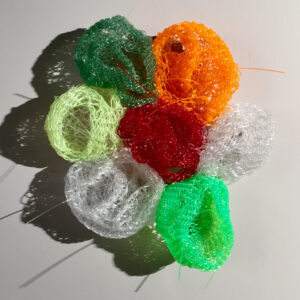
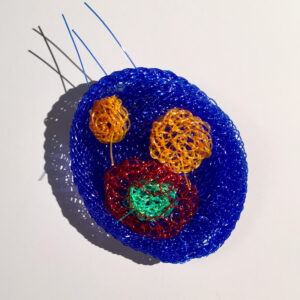
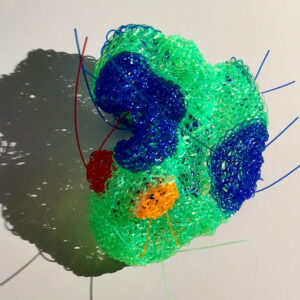
From the “Social distancing is awkward” series: Crochet mild steel and stone bead necklace
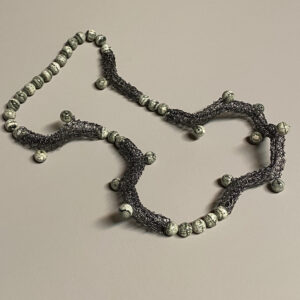
Steel brooch from the broken people series
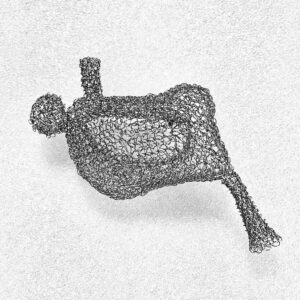
“Life persists in the Cracks” series: Crochet Argentium brooch with tourmaline beads
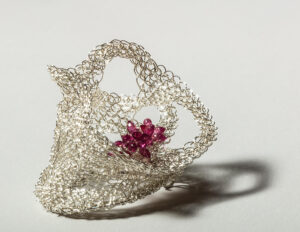
Gold filled 28 g wire, Argentium wire, white freshwater pearls
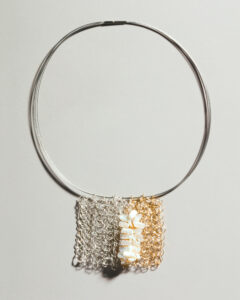
Transcript:
Physician-jeweler Michele Cottler-Fox struggled with dyscalculia—a math learning disability—as a child. When she began to study jewelry, she found math-heavy jewelry fabrication methods and measurements nearly impossible to understand. But instead of stopping her jewelry career in its tracks, this disadvantage pushed Michele to make her freeform crocheted metal designs. She joined the Jewelry Journey Podcast to talk about how she embraced her creative process; where her career as a physician and her career as a jewelry artist intersect; and why she loves crocheted designs.
Sharon: Hello, everyone. Welcome to the Jewelry Journey Podcast. This is the second part of a two-part episode. If you haven’t heard part one, please head to TheJewelryJourney.com. I am pleased to welcome Michele Fox to the Jewelry Journey Podcast. In addition to making a very unusual kind of jewelry, Michele is a physician who now works part time at the University of Arkansas Medical Center. Welcome back.
I have to say I was very impressed with how creative Little Rock was. I never thought I’d ever be in Little Rock, but it was a very creative town.
Michele: It has a strong art community. It was surprising to me how strong it is considering how small Little Rock is compared to Baltimore and Washington, but maybe I wasn’t as hooked into the communities in the city as I am here.
Sharon: Was it a big change to go from Baltimore or Washington to Little Rock?
Michele: It was a huge change. I came in 2000. When we got to Little Rock, there was no bakery making anything I recognized as bread. I thought, “How am I going to live here?” There was one butcher. There was almost no cheese that I recognized from Europe. But about a month after we got here, a couple who had lived and worked in San Francisco at very good food places came home, and they opened what they called Boulevard Bread, which is now Boulevard Bistro. Everything I had been missing was suddenly present.
Sharon: Did your profession influence the jewelry you were making? Did it matter at all?
Michele: It hasn’t influenced me very much. There’s a lot of plastic tubing in the machines I work with. At one point, I took the tubing home, filled it with stones and made a few necklaces, but it wasn’t satisfying somehow, not enough for my hands to do. So, I went back to the crochet hook.
Sharon: Do your patients comment on the things you’re wearing? Maybe you’re just wearing a lab coat. I don’t know.
Michele: I don’t wear a white coat at all because it makes people freeze. I want them to see me as a person, not a thing, so I always wear one of my brooches. It’s very often that the brooch breaks the ice in our conversation when I first meet a new patient. Some of them are so unlike anything people have seen before that before they even think about it, their mouth says, “What are you wearing? That’s so interesting.” I take it off. I let them hold it. We talk about it, and suddenly I’m a person, not a doctor. It’s a much better relationship that way, I think.
Sharon: It sounds like it’s surprising. They must be surprised that you would take off your pin, your necklace, and let them play with it.
Michele: They’re always a little shocked in the first place, but then they hold these things. As I said, the metal is so tactile, it almost feels like fabric. People turn it over, upside down, around and around, just because of the tactile sensation.
Sharon: Is that what attracted you to art jewelry versus, say, traditional jewelry?
Michele: I’m not 100% sure what it was that attracted me, except me that it was interesting and different. It allowed me to see what I made as part of a spectrum rather than just something weird and out of left field. I liked feeling that I was part of a new community that I had not realized existed.
Sharon: It’s interesting that you mentioned Betty Kessler because she was one of the first people I ever saw. I remember her, but I don’t remember the jewelry at all.
Do you go on trips to get ideas? Why do you go on the Art Jewelry Forum trips?
Michele: Very much to get ideas, but more to see how other people approach making things. Sometimes I’ll go round and round in my head for years trying to figure out how two things might relate to each other or might go together. Suddenly, on a trip, I’ll see something that makes me go, “Oh, dummy, why did you never think of that before?”
Sharon: That’s interesting.
Michele: I know what I’m supposed to be doing now.
Sharon: Do you usually come home and feel energized?
Michele: Always.
Sharon: When you go on these trips through Art Jewelry Forum, they are trips of the same 25, 20 people going year after year. I’ve seen people say, “I love what you’re wearing,” and you’ve taken it off and shown it to them. Would you say to a gallerist, “Here it is. I can make 25 of them”?
Michele: I’m still not sure how you best approach gallerists if your object is to sell something or become represented, but I have been in galleries where the gallerist has admired what I’m wearing, and I always take it off. I let them hold it and look at it, and I say, “This is my own work,” because I want to see what they think. I want to hear a spontaneous comment. Most of them have been very kind. One of the best criticisms I had early on was from Charon Kransen, who looked at my work and said, “It’s nice work, but you don’t need to be afraid.”
Sharon: Charon Kransen in New York.
Michele: It took me a long time to understand why he said that. I realized I was working in a very tight, very small fashion at the time, and that was the first clue I had to the fact that I could relax and start to open up what I was making. I didn’t need to be so tight and tiny and people could still like it.
Sharon: Did you ever go back to him and show him larger, more expansive pieces?
Michele: I’ve seen him at Schmuck in Munich wearing a piece of my bigger stuff.
Sharon: Wow! Are your colleagues surprised? Do you share that you make things? I’m thinking of my dentist. He has photographs around. Are they surprised you’re a maker?
Michele: When they first discover I’m a maker, yes, but I’ve been at my institution for 22 years now. A lot of people know I make jewelry. Most of the time what someone will say is, “Is that one of your pieces you’re wearing? I really like it.”
Sharon: Do you ever wear anybody else’s things, or only your things? I’ve only seen you in your things.
Michele: I have a nice collection of other people’s work. I do sometimes wear it, but I’m more likely to be wearing my own pieces.
Sharon: How do your colleagues find out that’s what you do? Do they overhear something?
Michele: They sometimes overhear. Two other jewelers and I have done a Christmas show at one of their homes for many years, and I always send colleagues invitations. So, some of them find out that way. I always tell them, “You’re welcome to bring friends if somebody else you know is interested.” In Little Rock people do things like that. They bring friends.
Sharon: These two jewelers who you do the show with, are they traditional jewelers? Are they hard-metal jewelers?
Michele: One is very much a high-end stone jeweler who designs custom jewelry, whose work I love and own. The other gal is somewhere between mine and hers. She works primarily with PMC.
Sharon: The polymer clay.
Michele: Yeah. It’s a good range in style and price. Every once in a while, somebody buys something from all three of us, which is a big day.
Sharon: Have you considered making other jewelry with anything else besides wire and the knitting?
Michele: I have worked with anything that looks and acts like string. I particularly love working with 30-pound-test fishing line because it comes in very bright colors and a broad range of colors. I actually find people have more difficulty dealing with those pieces than they do with the crocheted metal.
Sharon: You have to choose the color and the weight and all that, right? For the person who’s choosing the jewelry, that would be hard. I’ve never seen you wear it, but you do make brighter things.
Michele: Yes. The fishing line pieces are often the biggest pieces I make. I make flowers that will fill the entire center of your chest.
Sharon: Like a Sex and the City flower that was so popular. Do you ever crochet just for your own pleasure with yarn?
Michele: I really don’t crochet yarn. Having become accustomed to making solid, three-dimensional objects in wire, I’ve gotten to the point where yarn is frustrating because it’s soft and it collapses. I have combined yarn with metal and enjoyed doing that. I have combined plastic crocheted work with pearls and felted fabric that a friend makes.
Sharon: The stuff you wear, I’ve always seen just plain metals. You do have other things you make. Do you sell those? Do you put them out? Do you have them in galleries?
Michele: Everything I make, at the very least, goes out at the Christmas sale so I can get feedback from people. The one thing I love about selling, aside from the fact that it’s very nice to see people want your work enough to actually pay for it, is to see people react to the new pieces. I get to see whether they like it, whether they don’t like it, and, if so, why. It helps me get a better understanding of how other people see my work.
Sharon: Have you ever liked something a lot that other people didn’t like? Did you modify what you were doing? Has it impacted you?
Michele: It’s disappointed me. I really love the fishing line work, but there aren’t a lot of other people who do, at least in Little Rock. It hasn’t stopped me from making the pieces. I just have a lot of it at home; that’s all.
Sharon: I have to start going fishing. It seems a little awkward—I don’t know if they would do it in L.A.—but would they come up and say, “Oh, that’s so good. I’ve got to try it myself”?
Michele: Oh yeah, sure, but I warn them that it’s quite a different thing to crochet metal than to crochet yarn. The way they’re used to working with the hook is not going to work with the metal. When I started there were no books about it, so I had to work things out on my own. There are now several books that will tell you how to crochet with metal, but the other thing about my work is that I don’t crochet traditional patterns. There are other people who do fabulous pattern work in wire, whose work I admire and some of which I own, but that’s not what I do. I’m literally sculpting a form out of a sheet of metal fabric as I work.
Sharon: Do you think if you were more, I don’t want to say exacting, but if you didn’t have this issue with the numbers and measuring, do you think it would be different?
Michele: I’m sure it would be. I don’t know that I would ever have started crocheting. I would probably have stuck with fabrication.
Sharon: Is a lot of your work freeform because of it? You’re not counting; you’re not following a pattern; you’re not saying how big it should be.
Michele: Exactly. My eye is very good at judging size and distance and shape. As a kid, I would frustrate my geometry teacher enormously because she would see that I had produced on a test exactly the shape I was supposed to produce, but she could see that the points where my protractor had been were absolutely incorrect. She couldn’t figure out how I was getting the right shape. I just coped with what could have been a major hindrance. There are always workarounds. They are ways to do what you need to do if you just keep at it.
Sharon: Is that something you’ve had to explain to people who don’t do what you do, who may have been stopped by the fact that they couldn’t count how many stitches? Do you say that?
Michele: I tell them that what I’m doing is nontraditional and I can’t help them with understanding the patterns. I just encourage them to work at it, to not get frustrated. The other thing I learned was that as I’m making something, it will always look ugly early on. There’s just no way around it. At some midpoint in making a piece, it suddenly turns into what I want. That moment, when it suddenly becomes a thing, is really wonderful. It’s precious.
Sharon: Your jewelry can be worn in so many ways. Do you make something that might be a pin or might be a hairclip? Do you decide before you start what it’s going to be?
Michele: I know what I think I’m making when I start. More than once, I’ve discovered once I finish it that it’s really something else. I also like playing with my jewelry, as you know, so I have many pieces that are multifunctional. One of my new favorites is a bracelet, or what I meant to be a bracelet, which turned into a pin. I prefer it as a pin to a bracelet, but it also works as a pendant. I need to decide how I’m going to sell these things. Should I tell someone, “You think you’re buying a pin, but if you unwind the pin back off it, you have both a bracelet and a pendant.” Most people don’t want to play with their jewelry. They want it to be a thing and worn as that thing.
Sharon: I relate to that because I want it one way. Would you then go back and make something that can be made into a pin??
Michele: I can. If someone says, “Could you please make it a permanent pin?” that’s easy. To make it a permanent pendant, all I’d do is take the pin back off and string a chain through it. But to my mind, a multifunctional piece is a lot more fun.
Sharon: What if somebody came along and said, “I’m looking for a bracelet,” or “I’m looking for a necklace”? Would you say to somebody, “I could just make a bracelet,” not even showing them what you have? Could you make a bracelet that’s just a bracelet?
Michele: Oh, I do make things that are just one thing. I have a very tall bottle which I have stacked bracelets on. It was like a bracelet tower. Although I have noticed that sometimes I take round bracelets and put a chain through them and suddenly have a pendant. I can’t help myself.
Sharon: I have to say I have seen people, at least from our group, grab what you have and want to touch it or buy it. They’re like, “Oh, this is so different and unusual.” My number two thing I always remember about you is something I was so surprised by. You said to me once, “Go look at this place. They have bracelets.” Bracelets are my thing. You said, “You might like them.” I was really surprised, because there are a lot of bracelets in the world and a lot of bracelets I don’t like, but I felt like Michele knew what I liked. I think that’s very surprising when it comes to jewelry.
Michele: I spend a lot of time looking at how other people wear jewelry, trying to understand why someone chooses to wear what they wear. I think I have a good gestalt sense of what people might like. Sometimes they surprise me, but I’m a pretty good judge of what somebody’s going to like.
Sharon: When you’re making things you know are going to go on a Christmas sale, do you make, let’s say, more pins because you know people like more pins, or they want more bracelets or more necklaces? Do you think about that?
Michele: No, actually, I try to make, or at least take to the show, roughly equal amounts of different kinds of things. Someone who wanted all bracelets last year quite often will come back this year and want necklaces.
Sharon: That’s interesting.
Michele: The other thing I’ve noticed is that, with my work at least, people often buy earrings first because they’re smaller. They’re not sure about this crocheted metal stuff, but if they like the earrings, they’ll very often come back and want a bracelet or a necklace next year.
Sharon: Do you think it’s different in Little Rock than it would be in a larger place? Would they be more discombobulated, maybe? That’s not the right word, but—
Michele: I think in the beginning people in Little Rock had a lot of difficulty deciding what they thought about my work. There were always a few people who were enthusiastically positive. As they wore the work around, people got used to seeing it and it wasn’t so strange anymore. Over time, I think generally women have been changing what they wear for jewelry. It’s not so much the gold and big stones. It’s a “nothing else matters” kind of approach to jewelry. People are more willing to take a chance on something that looks a little different or a little bit funky.
Sharon: I don’t think I’ve even seen any of your kind of jewelry. We’ll have pictures, as I said, on the website, but I’ve never seen jewelry that looks like yours. Thank you so much for being with us today and for sharing your background.
Michele: It was my pleasure. Thank you for having me.
We will have photos posted on the website. Please head to TheJewelryJourney.com to check them out.
Thank you again for listening. Please leave us a rating and review so we can help others start their own jewelry journey.

